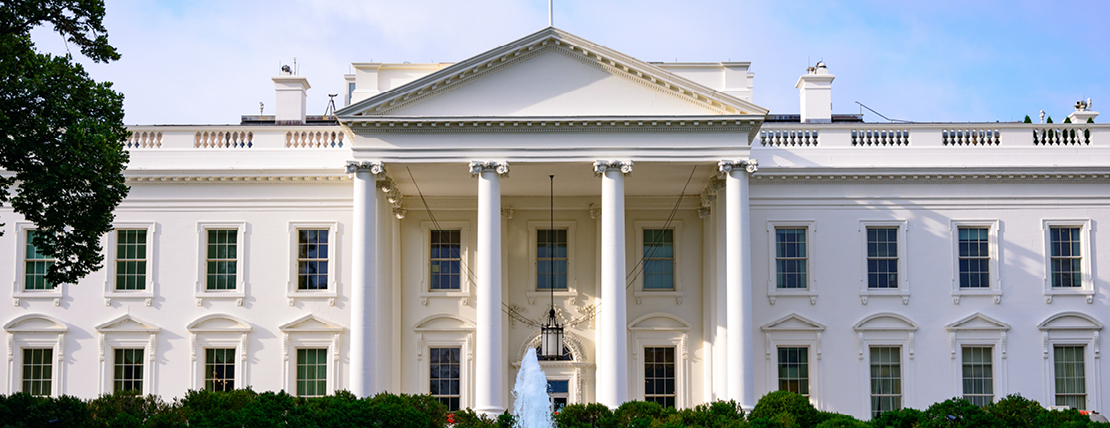For WorldatWork Members
- Engage Community, peer engagement and connection platform
- DEI Priorities Pulse Poll, research
- Pay Equity Laws by State — Are You in Compliance? tool
For Everyone
- The HR Horizon: Total Rewards Takeaways from the Recent U.S. Election, Workspan Daily article
- FTC Takes Next-Step Actions in Noncompete Rule Appeal Case, Workspan Daily article
- What’s Topping Compensation Committee Agendas in 2025? Workspan Daily article
The second administration of President Donald Trump started promptly, boldly and contentiously on Monday, Jan. 20, with the new U.S. leader signing a litany of executive orders and implementing additional Presidential actions that he said will help improve governmental performance and restore the nation’s prominence in the world.
Executive Orders
Among the orders signed in front of a crowd of supporters at Capital One Arena in Washington, D.C., were several with strong human capital/human resources/total rewards undertones and implications.
Diversity, Equity and Inclusion Programs
Trump’s executive order titled “Ending Radical and Wasteful Government DEI Programs and Preferencing” directly targeted federal diversity, equity and inclusion (DEI) programs and requirements. The action aligned with a campaign promise to “terminate federal staffers implementing DEI policies.”
During his inaugural address earlier in the day, Trump stated he would “end the government policy of trying to socially engineer race and gender into every aspect of public and private life.” He added, “We will forge a society that is colorblind and merit-based.”
The executive order rescinded one created by former President Joe Biden that provided agencies with “information, resources and a methodology to assess” workforce diversity, equity, inclusion and accessibility (DEIA). Biden’s order aimed to establish a “government-wide initiative to promote diversity” in the federal workforce.
Verbiage in Trump’s executive order stated: “The director of the Office of Management and Budget (OMB), assisted by the attorney general and the director of the Office of Personnel Management (OPM), shall coordinate the termination of all discriminatory programs, including illegal DEI and ‘diversity, equity, inclusion and accessibility’ (DEIA) mandates, policies, programs, preferences and activities in the federal government, under whatever name they appear.”
The OPM director, with assistance from the attorney general, will review and revise, as appropriate, all existing federal employment practices, union contracts and training policies/programs to comply with this executive order.
The order applies to both hiring practices and the evaluation, development and rewarding (via promotions, incentives, etc.) of existing employees. It stated, “Federal employment practices, including federal employee performance reviews, shall reward individual initiative, skills, performance and hard work and shall not under any circumstances consider DEI or DEIA factors, goals, policies, mandates or requirements.”
With a deadline of Friday, March 21, all U.S. agency, department and commission leaders — in consultation with the attorney general and the directors of the OMB and OPM — must execute a number of tasks, including:
- “Terminate … all DEI, DEIA and ‘environmental justice’ offices and positions (including but not limited to ‘chief diversity officer’ positions); all ‘equity action plans,’ ‘equity’ actions, initiatives or programs, ‘equity-related’ grants or contracts; and all DEI or DEIA performance requirements for employees, contractors or grantees.”
- “Direct the deputy agency or department head to … assess the operational impact (e.g., the number of new DEI hires) and cost of the prior administration’s DEI, DEIA and ‘environmental justice’ programs and policies; and recommend actions … to align agency or department programs, activities, policies, regulations, guidance, employment practices, enforcement activities, contracts (including set-asides), grants, consent orders and litigating positions with the policy of equal dignity and respect identified in Section 1 of this order.”
Gender Identification
An executive order titled “Defending Women from Gender Ideology Extremism and Restoring Biological Truth to the Federal Government” focused on biological sex and gender identity and outlined a policy where, for federal purposes, only two sexes are recognized: male and female. Under the order, these sexes are “not changeable and are grounded in fundamental and incontrovertible reality.” Specific gender-based definitions will govern all executive branch interpretation of and application of federal law and administration policy. Within these definitions, the order stated, “‘Sex’ shall refer to an individual’s immutable biological classification as either male or female. ‘Sex’ is not a synonym for and does not include the concept of ‘gender identity.’”
The order went on to state, “Agencies will cease pretending that men can be women and women can be men when enforcing laws that protect against sex discrimination.”
The policy will be reflected in all official government documents, including passports, visas and Global Entry cards.
Since 2022, U.S. citizens have been able to select “X” as their gender marker on passports. Prior State Department policy stated, “One’s marker does not need to match the gender on citizenship documents or photo ID, nor is medical documentation needed to change one’s gender.” In late 2022, Americans were allowed to change their sex identification with the Social Security Administration without needing to provide medical certification.
Civil rights advocates have said Trump-implemented rollbacks of DEI policies/programs and transgender rights would be a blow to efforts to secure equitable policies and governmental, societal and workplace treatment as well as undermine progress made to address systemic prejudices that have deprived equal opportunities for marginalized groups for decades.
Hiring Processes and Decisions
Trump’s executive order titled “Reforming the Federal Hiring Process and Restoring Merit to Government Service” took aim at governmental hiring practices. It stated, “Current federal hiring practices are broken, insular and outdated. They no longer focus on merit, practical skill and dedication to our Constitution.”
Within the order, Trump pointed to DEI policies as a root cause: “Federal hiring should not be based on impermissible factors, such as one’s commitment to illegal racial discrimination under the guise of ‘equity’ or one’s commitment to the invented concept of ‘gender identity’ over sex. Inserting such factors into the hiring process subverts the will of the people, puts critical government functions at risk and risks losing the best-qualified candidates.”
Trump wrote that a revamped federal hiring plan will:
- “Prioritize recruitment of individuals committed to improving the efficiency of the federal government”;
- “Prevent the hiring of individuals based on their race, sex or religion”;
- “Implement, to the greatest extent possible, technical and alternative assessments as required by the Chance to Compete Act of 2024”;
- “Decrease government-wide time-to-hire to under 80 days”;
- “Improve communication with candidates to provide greater clarity regarding application status, timelines and feedback, including regular updates on the progress of applications and explanations of hiring decisions where appropriate”; and,
- “Integrate modern technology to support the recruitment and selection process, including the use of data analytics to identify trends, gaps and opportunities in hiring, as well as leveraging digital platforms to improve candidate engagement.”
The order also called out “The federal hiring plan shall provide specific best practices for the human resources function in each agency, which each agency head shall implement, with advice and recommendations as appropriate from DOGE [the Department of Government Efficiency].”
Presidential Actions and Memorandums
Among the additional actions and memorandums Trump initiated on the evening after his inauguration were ones focused on governmental efficiency, cost and performance.
Work and Workplace
Of particular note was a memo titled “Return to In-Person Work,” which was succinct (just 65 words) and to the point. It stated, “Heads of all departments and agencies in the executive branch of government shall, as soon as practicable, take all necessary steps to terminate remote work arrangements and require employees to return to work in-person at their respective duty stations on a full-time basis, provided that the department and agency heads shall make exemptions they deem necessary. This memorandum shall be implemented consistent with applicable law.”
Hiring and Payrolls
A memo titled “Hiring Freeze” halts the hiring of federal civilian employees. It stated, “As part of this freeze, no federal civilian position that is vacant at noon on January 20, 2025, may be filled, and no new position may be created except as otherwise provided for in this memorandum or other applicable law. Except as provided below, this freeze applies to all executive departments and agencies regardless of their sources of operational and programmatic funding.”
This order does not apply to military personnel or positions related to immigration enforcement, national security or public safety.
In addition, by Sunday, April 20, the OMB director, in consultation with the OPM director and the DOGE administrator, will submit a plan to reduce the size of the federal government’s workforce “through efficiency improvements and attrition.”
Regulation Development
A memo titled “Regulatory Freeze Pending Review” laid out the following orders to all executive departments and agencies:
- “Do not propose or issue any rule in any manner, including by sending a rule to the Office of the Federal Register [OFR], until a department or agency head appointed or designated by the President after noon on January 20, 2025, reviews and approves the rule. … The director or acting director of the [OMB] may exempt any rule that he deems necessary to address emergency situations or other urgent circumstances, including rules subject to statutory or judicial deadlines that require prompt action.”
- “Immediately withdraw any rules that have been sent to the OFR but not published in the Federal Register, so that they can be reviewed and approved.”
- “Consider postponing for 60 days from the date of this memorandum the effective date for any rules that have been published in the Federal Register, or any rules that have been issued in any manner but have not taken effect, for the purpose of reviewing any questions of fact, law and policy that the rules may raise.”
For two rules that have generated a lot of publicity and legal challenges in recent months:
- The Federal Trade Commission’s noncompete final rule was published in the Federal Register on May 7, 2024 (with an effective date of Sept. 4, 2024).
- The Department of Labor’s final rule updating the salary threshold for overtime exemptions was published in the Federal Register on April 26, 2024 (with an effective date of July 1, 2024).
Editor’s Note: Additional Content
For more information and resources related to this article, see the pages below, which offer quick access to all WorldatWork content on these topics:







